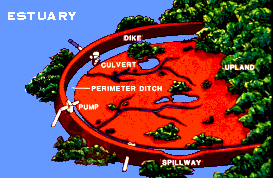Impoundments
A mosquito control impoundment is a salt marsh or mangrove forest with an earthen dike around the perimeter that allows the area to be artificially flooded during the mosquito breeding season (approximately May to October). The salt marsh mosquitoes Aedes taeniorrhynchus and Aedes sollicitans will not lay their eggs upon standing water. Instead, they oviposit upon moist soil; the eggs hatch when flooded by tides or rainfall and develop into adults within 5 - 7 days. Flooding marshes during the breeding season, thus totally eliminates mosquito production from the area without having to use pesticides.

Over 16,000 ha of productive coastal salt marshes and mangrove forests along the Indian River Lagoon have been impounded for mosquito control. Research during the past 10 years, has shown that impounding can have severe environmental impacts on the marshes and the adjoining estuary. Of particular concern are degradation of water quality, isolation of habitat needed by sport and commercially important fishery species during critical times in their life cycles, elimination of productive marsh vegetation, adverse impacts on estuarine seagrasses, and interruption of the free flow of nutrients and organisms between wetlands and the lagoon.
The same body of research, however, has been used to develop management techniques that mitigate many of these adverse effects while retaining the capability to control mosquitoes without having to use potentially harmful pesticides in these fragile areas. Some of these techniques, such as Rotational Impoundment Management (RIM) and cyclic management for waterfowl and shore bird habitat enhancement, have been tested and used repeatedly in the lagoon; others are continuously being evaluated.
More information on impoundments can be found under Wetlands and Estuarine research.
- Back to Natural Habitats at FMEL
